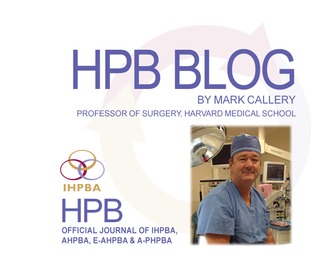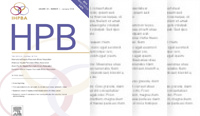International Hepato-Pancreato-Biliary Association
HPB Blog, August 2017

In its August 2017 issue now available on line, HPB offers its readership an exciting blend of original articles sure to please. During editorial review and now better while reading the published content, I have been struck by the depth and quality of the studies as well as the practical and timely knowledge they provide. I’m sure this trend has contributed to the terrific climb of our Impact Factor to 3.29!
August offers two systematic reviews for your evidence-based appetite. Silva et al systematically review survivals, complication rates and treatment responses following transarterial chemoembolization (TACE) for hepatocellular carcinoma (HCC) patients with portal vein thrombosis (PVT). They evaluate 13 studies involving 1933 patients, and find that TACE is a safe treatment for HCC with PVT for carefully selected Child-Pugh class A and B patients. Time will tell how TACE will be embraced going ahead. What is the optimal treatment for solitary HCC >5cm? In their meta-analysis of 4 cohort studies involving 861 such patients, Stevens et al evaluate long-term survival outcomes of hepatic resection versus TACE for solitary large tumours. The results favor resection over TACE for solitary >5cm HCC because of relative longer intervals to disease progression and greater overall survivals. As HCC treatment guidelines are refined in the years ahead, these two HPB offerings will likely catch attention.
For H- Liver, there is a bounty of original articles to enjoy. Feng et al offer results of a prospective randomized trial that indicate anatomic resections are superior to non-anatomic resections in reducing HCC local recurrence rates. There were no differences however in recurrence-free survival. Beamish et al suggest recent advances in the overall care of colorectal cancer liver metastases (CRLM) warrant a re-evaluation of a long-established clinical risk score (CRS) that predicts survival following hepatectomy for CRLM. Has this CRS withstood the tides of improved clinical care and time? Is it still relevant? Truant et al evaluate the clinical factors associated with fatal liver failure after extended hepatectomy in a large (n=285) single centre cohort. It’s surprising to see how infrequently actual hepatic failure caused death. Clarke et al evaluate the feasibility and accuracy of conventional MR imaging for quantification of hepatic steatosis. Relatively routine and widely available quantitative MR techniques appear to be quite effective at their centre.
For P- Pancreas, we find two articles from Birmingham, UK. Roberts et al evaluate a straight to surgery “fast track pathway” designed to obviate the need for biliary stenting prior to definitive pancreaticoduodenectomy (PD) for jaundiced patients with periampullary malignancy. It is a 12 month observational study prone to selection bias as the authors note. Regardless, the pathway took traction and worked within the NHS, and delivered many more patients much sooner for potentially curative resection. Halle-Smith et al compare risk factors for pancreatic fistula for PD versus distal pancreatectomy (DP). Again, we see pancreatic duct width and gland texture as important for PD. The only true risk factor for DP fistulae related to underlying disease (higher with PNET, benign disease). Do note that 8 PD patients suffered ISGPF Grade C fistulae while no DP patient did.
For B- Biliary. On behalf of 12 international centres, Buettner et al compare survivals for LN+ perihilar cholangiocarcinoma (PHC) patients undergoing resection against those for patients explored but not resected because of locally-advanced disease. Resection extended survival by 20% at years 1 and 3. As the authors note, it’s by no means a controlled comparison given so many variables over time (14 yrs) in both groups. Gordon-Weeks et al surveyed experienced GI surgeons as to why bile duct injuries (BDI) occur. Are BDIs the result of bad risk assessment, system failures, technical errors, or de facto negligence? Read on.
Enjoy your August 2017 issue, and thanks for supporting HPB! Also, please take a look at our Virtual Journal Club offerings for HPB. We hope they will facilitate learning and updating for our readership.
Mark P. Callery, MD, FACS
Professor of Surgery
Harvard Medical School
Corporate Partners
If you are interested in becoming a Corporate Partner of the IHBPA please contact industry@ihpba.org
Find out more


